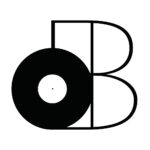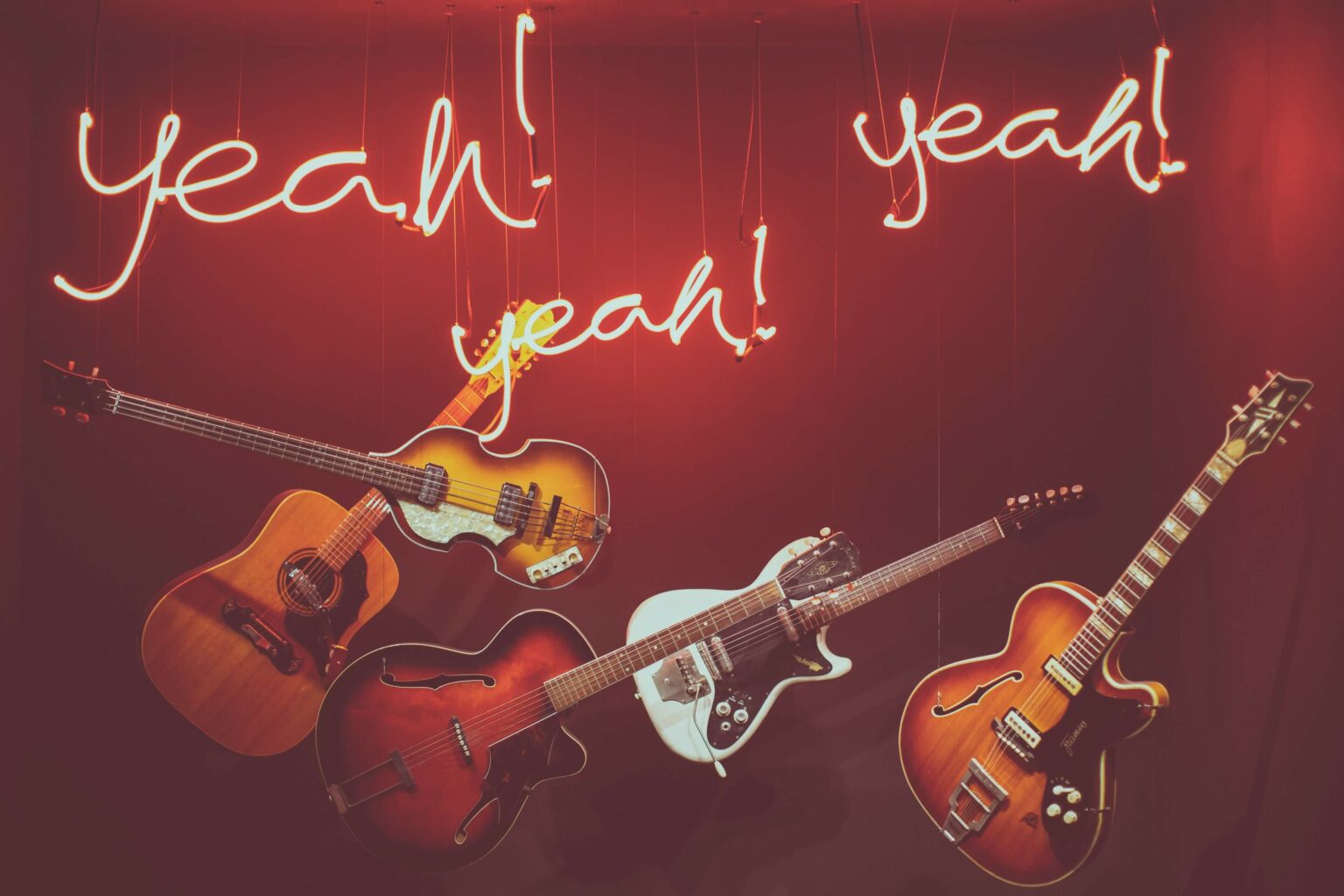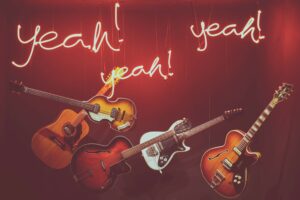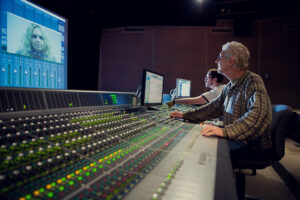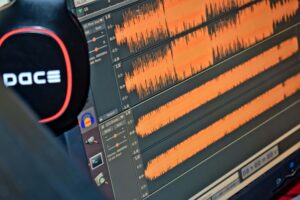What if the bass player doesn’t show up? Is it difficult to find competent bass players in your area? I guess you could learn how to play bass (which I highly recommend), but you can also learn how to record bass with a guitar using octavers, pitch shifters and/or harmonizers.
Learning how to record bass with a guitar isn’t complicated. If you’re using GarageBand/Logic Pro, you can achieve all of this using its default plugins. I’m talking about using octavers, pitch shifters and harmonizers to transpose your electric guitar to the same range as the bass guitar (one octave below). The results are pretty satisfying if you’re doing things properly which is why you’ll definitely want to read the rest of this article!
- How to record bass with a guitar using an octaver
- How to record bass with a guitar using a pitch shifter
- How to record bass with a guitar using a harmonizer
- Using amplification to record bass with a guitar
- The best stompboxes to record bass with a guitar
- The best plugins to record bass with a guitar
- Should you really be recording bass with a guitar?
How to record bass with a guitar using an octaver
One of the simplest ways to record bass with a guitar is to use an octaver stompbox/plugin. Octavers are normally used to thicken up single-note lines by adding an extra octave or two (either above or below the original pitch).
Since the guitar is tuned one octave above the bass, we’re simply trying to transpose it down one octave (or -12 semitones).
Some octavers even included an additional “sub-octave” which is TWO octaves below (or -24 semitones).
To complete the illusion, we’ll actually need our stompbox/plugin to have what we refer to as a mix knob or a dry/wet knob. It’ll be used to completely remove the original signal leaving us with the lower octave(s) exclusively.
After inserting an octaver into your signal chain and adjusting it accordingly, you’ll get something that sound like more of a synth-bass rather than a bass guitar.
That’s fine!
It’s only natural because octavers are actually synthesizing those additional octaves. In other words, octavers are basically synthesizers. Think of it like working with multiple oscillators!
How to record bass with a guitar using a pitch shifter
My favourite way to record bass with a guitar is to use pitch shifter stompboxes/plugins. Instead of generating additional octaves, the pitch shifter actually takes your instrument’s signal and transposes it up/down.
In other words, there’s no synthesis involved.
Some pitch shifters can even transpose entire chords (most fail to achieve this though).
Either way, we simply need our pitch shifter to transpose our guitar to the range of a bass. That means -12 semitones or -1 octave depending on the effect you’re working with.
Once that’s taken care of, you’ll notice that pitch shifters make your guitar sound pretty much identical to a bass guitar. It’s not synth-like at all.
The only thing you’ll need to keep in mind is the quality of your pitch shifter.
Make sure it can track your notes quickly and effectively without glitching/artifacts.
How to record bass with a guitar using a harmonizer
The last effect we’ll be using to record bass with a guitar is the harmonizer. It’s very similar to the octaver, but it’s designed to target specific intervals (not just octaves).
In other words, you can transform single-note lines into chordal passages.
It’s the same concept as vocoding, except it’s not necessarily controlled by a keyboard.
The only thing you’ll need to make sure of is that your harmonizer can, in fact, remove the original signal from your mix. Most of the time, you’re looking for a mix or dry/wet knob. You’ll also want to make sure it can harmonize an octave lower than your original pitch.
Depending on the process used by your harmonizer, it may sound like a bass guitar or like a synth-bass. Make sure to verify whether it multiplies the original signal and transposes it OR whether it generates new signals through synthesis.
Using amplification to record bass with a guitar
Assuming you’ve inserted one of the three devices into your signal chain, you’ll still need to consider amplification. It should be the second thing in your signal chain and it obviously shouldn’t be a guitar amp. Right?
Well, it really depends on the sound you’re going for…
Bass players often use guitar amps (or guitar amp simulators) to get their desired sound.
Whether you’re using stompboxes and/or plugins, you’ll have the option to use physical amplifiers or modelled amplifiers by plugging straight into your audio interface.
For example, you could use an octaver stompbox and plug that into your audio interface.
You could also record using an amplifier (bass or guitar) and use one of these plugins during post-production. However, I think it’s better to insert the effect first into your signal chain. It’s much more effective to transpose the dry/original signal.
That being said, I think it’s more authentic to follow that up with a bass amp rather than a guitar amp.
Considering the fact that we’re using a guitar to record bass, it’ll make the illusion that much more satisfying!
The best stompboxes to record bass with a guitar
If you’re looking for stompboxes that’ll allow you to record bass with a guitar, I’m going to be recommending two of my personal favourites. Obviously, they’re much more useful than that, but I guarantee that they can at least accomplish this task.
The first pedal we’ll be talking about is the Digitech Whammy 5.
Digitech Whammy 5
It’s probably the most popular pitch shifter on the market and has benefited from some major upgrades over the years (especially for the 5th generation model). It now has the ability to pitch shift entire chords without sounding glitchy.
Of course, that’s not essential. However, it really demonstrates the overall quality of the Whammy 5.
It also has the ability to harmonize (it’s technically also a harmonizer).
You’ll have the ability to transpose your instrument to various intervals up or down. The maximum range is 2 octaves up/2 octaves down. It’s also true-bypass for you audiophiles out there. It can be powered with the included AC adapter.
The second pedal we’ll be looking at is the TC Electronics Sub ‘N’ Up.
TC Electronics Sub ‘N’ Up
It’s my octaver of choice because it’s both affordable and simple.
It allows you to add one octave below and two octaves below the original if you desire. It also allows you to add some drive to get more sounds. However, the most important part is the dry signal knob which allows you to remove your original guitar signal from the mix.
If you’re just looking for something to get the job done (recording bass with guitar) and potentially adding more colour to your tonal palette, then look no further!
Just keep in mind that it will sound synth-like.
The best plugins to record bass with a guitar
For the sake of convenience, I think most of us would be better off using plugins to record bass with a guitar. Since I use both Logic Pro X and Universal Audio plugins, we’ll be taking a look at some of my favourites.
Keep in mind that GarageBand includes most of the effects included Logic Pro X (but it’s completely FREE).
We’re actually going to start by looking at Logic Pro/GarageBand’s version of the Digitech Whammy; the “Wham”. It’s obviously not as good as the real thing, but it’ll get the job done without any additional expenses.
Logic Pro X’s “Wham”
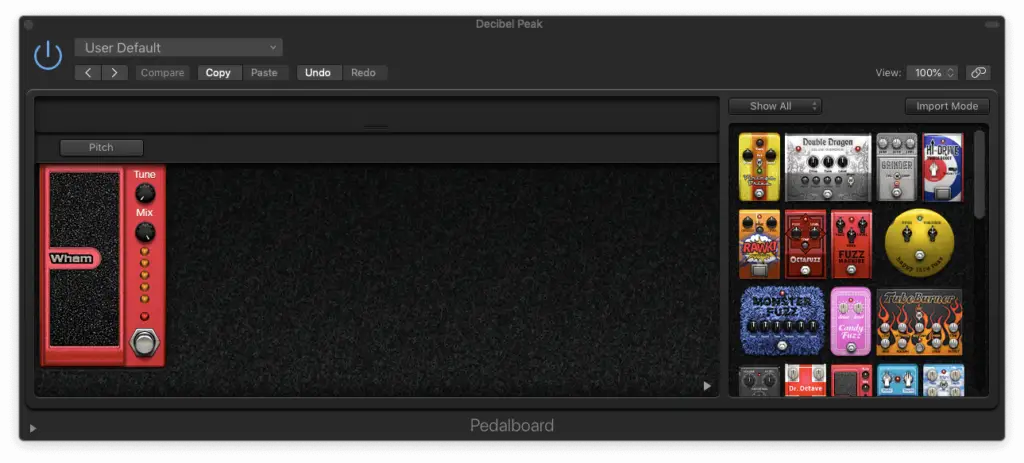
It’s got the same features as the original Digitech Whammy.
It’s much simpler to use though. You’ll simply need to:
- Set the tuning to -12 semitones
- Set the mix knob to 100%
- Engage the expression pedal 100%
Make sure you’ve enabled monitoring and you should have your bass!
The second Logic Pro X plugin we’ll be looking at is the “Dr. Octave”.
Logic Pro X’s “Dr. Octave”

I’m actually not sure which pedal they were trying to emulate, but it looks almost identical to the Sub’N’ Up from TC Electronics. It’s got the same ability to add both a bass octave and a sub-octave. It’s also got the ability to remove the dry signal and add some saturation.
Here’s what I did:
- Octave 1 at 100%
- Octave 2 at 0%
- Direct at 0%
- Drive at 50%
Try experimenting with different pickup combinations as well!
Moving on to Universal Audio, we’ll find one more interesting option!
Universal Audio’s “bx_subsynth”

One of their best plugins in my opinion is the bx_subsynth.
It’s not your typical octaver though. It’s actually considered a subharmonic synthesizer (which is actually what an octaver is), but it’s not designed for the same purpose.
Instead of targeting specific intervals (like the octave), the bx_subsynth basically adds lower harmonics to your sound resulting in a “bassier/full-body” tone.
It’s more difficult to get it sounding like a bass guitar, but I find the results much more satisfying. It’s still got that slight guitar sound if you use your bridge pickup, but the neck pickup makes it sound more like a bass.
You’ll need to mix the three different subharmonics yourself.
It’s not possible to completely remove the original signal. However, you easily “drown it out” by increasing the volume of each subharmonic.
Should you really be recording bass with a guitar?
Some of us can’t afford a bass guitar. Some of us can’t afford to learn how to play bass guitar. However, I personally don’t think those are valid reasons to replace the bass guitar with a guitar.
I learned how to play bass quite easily after playing guitar for over 10 years.
That being said, I know some of you might be looking for a quick fix. Maybe some of you actually want to record bass with a guitar for artistic purposes. It could be interesting and fun!
Either way, rest assured that it’s most certainly possible and that there are many more plugins available to you for this task. I simply went over the plugins I’d personally use and truly believe that they’ll provide excellent results.
I think the Digitech Whammy 5 is your best bet though!
If you’re into plugins, just use the stock Logic Pro/GarageBand plugins.
Just remember that you’ll need to enable monitoring to hear your plugins while recording and that could cause audio latency issues. That’s why I mentioned Universal Audio. If you’re not familiar with UAD plugins and their ability to record in real-time with near-zero latency, check out this article.
I still recommend the Whammy 5 though. However, you could most likely find a bass guitar at the same price point, so I’ll let you decide what’s best!
I’ll be leaving you with some links to check out. If you have any questions, leave them in the comment! Also, make sure to let us know WHY you wanted to learn how to record bass with a guitar!
I hope you enjoyed learning how to record bass with a guitar. It’s not as difficult as it sounds and it can actually yield some pretty convincing results. Just keep in mind the order of your signal chain and try to minimize any unnecessary effects along the way. If you’re looking for more tutorials on how to record bass guitar at home, I recommend checking out some of the other articles I’ve written. Thanks for reading!
